Creating a Unique Cursor: A Guide to Customizing Cursor Styles
Introduction
With the fast-evolving world of web design and development, creating a unique and engaging user experience has become essential. One often overlooked aspect of customization is the cursor. By default, web browsers offer a standard cursor, but did you know that you can personalize it to match your branding or enhance the overall aesthetic of your website? In this article, we will explore the concept of custom cursor styles, their benefits, and how you can implement them in your HTML code.
Understanding Custom Cursor Styles

Custom cursor styles allow you to replace the default cursor with unique, eye-catching designs. This ability to customize the cursor provides an additional layer of branding for your website, helping it stand out from the crowd. By carefully selecting a cursor style that complements your website's theme and purpose, you can create a more enjoyable and immersive browsing experience for your users.
Implementing Custom Cursor Styles

Implementing custom cursor styles is relatively simple, thanks to CSS and HTML. Let's take a look at the step-by-step process:

1. Create the Cursor Image
The first step in implementing custom cursor styles is to create an image that will serve as your cursor. The image should be in a compatible format, such as PNG or GIF, and have a transparent background. Keep in mind that the cursor image should ideally represent your brand or website theme.
2. Define the Custom Cursor in CSS
Once the cursor image is ready, you need to define it in your CSS code. You can do this by using the cursor property. For example, to implement a custom cursor style called \"example-cursor.png,\" you would add the following CSS code:
This CSS code sets the custom cursor image as the default cursor for the entire webpage. The \"auto\" keyword ensures that the browser will switch to an appropriate fallback cursor if the custom image fails to load.
3. Apply the Custom Cursor Style to HTML Elements
After defining the custom cursor in CSS, you can apply it to specific HTML elements that you want to customize. To do this, you can use the CSS cursor property within the respective element's selector. For instance, if you want to apply the custom cursor style to all links on your website, you would use the following CSS code:
You can also apply the custom cursor to other HTML elements such as buttons, images, or even specific sections of your webpage. The flexibility of CSS allows you to unleash your creativity and experiment with different cursor styles.
Advantages of Custom Cursor Styles
Custom cursor styles offer several advantages that can greatly enhance the user experience on your website:
1. Branding and Aesthetics
By using a custom cursor style that aligns with your branding, you can create a cohesive visual experience for your users. This subtle branding element helps reinforce your website's identity and makes it more memorable.
2. Improved User Engagement
A unique cursor style can pique the curiosity of visitors, encouraging them to explore and interact more with your website. This increased engagement can lead to longer visit durations and a lower bounce rate.
3. Enhanced User Experience
A well-designed custom cursor can contribute to the overall user experience by providing visual feedback or guiding users' attention to specific elements on your webpage. For example, a cursor in the shape of a pointing hand can indicate clickable buttons or links, making navigation more intuitive.
Conclusion
Customizing cursor styles is a simple and effective way to add a unique touch to your website. By carefully selecting a cursor that represents your brand and implementing it using CSS and HTML, you can create a more visually appealing and engaging user experience. So, why settle for the default browser cursor when you have the opportunity to customize it and make your website truly stand out?
















